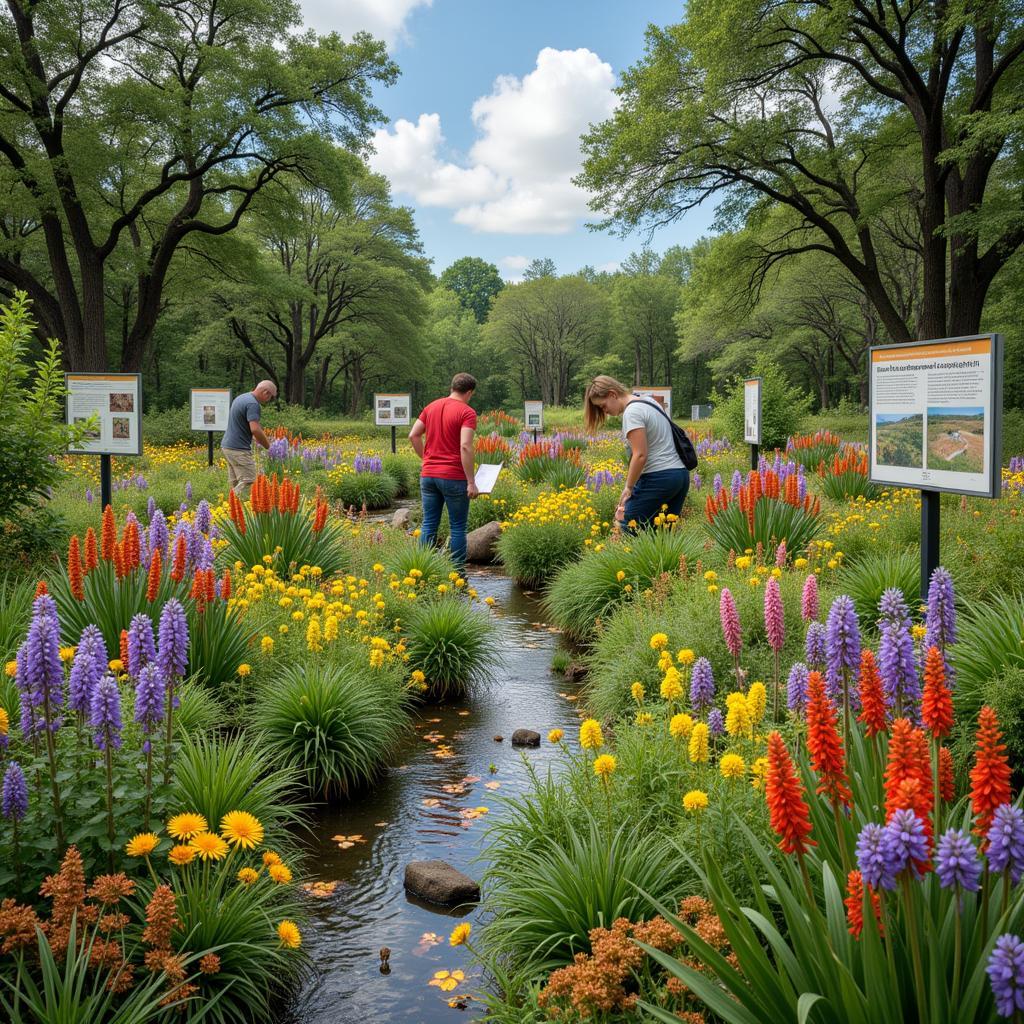The IELTS Speaking test often includes questions about nature and the environment, particularly plants or trees significant to one’s country. This topic allows candidates to showcase their knowledge of local flora while demonstrating their English language skills. Let’s explore how to effectively answer questions related to describing an important plant in your country, with a focus on achieving a high band score.
Part 1: Introduction and Interview
In this section, the examiner may ask general questions about plants and nature. Here are some possible questions and sample answers:
- Do you like plants?
- Have you ever grown any plants?
- What’s your favorite plant?
Let’s focus on the third question:
Sample answer (Band 8-9):
“My favorite plant is undoubtedly the lotus. I’m utterly fascinated by its symbolic significance in my culture, representing purity and enlightenment. What truly captivates me is how it emerges unscathed from muddy waters, blooming with pristine beauty. Its resilience and ability to thrive in challenging conditions never fail to inspire me.”
Part 2: Long Turn
Here’s a sample cue card related to the topic:
Describe a plant or tree that is important in your country
You should say:
- What the plant or tree is
- Where it can be found
- Why it is important
- And explain how you feel about this plant or tree
Sample answer (Band 6-7):
“I’d like to talk about the bamboo plant, which is quite important in my country. Bamboo can be found in many parts of our country, especially in rural areas and forests. It’s a very versatile plant that grows quickly and has many uses.
Bamboo is important for several reasons. First, it’s used in construction, especially for building traditional houses and scaffolding. It’s also used to make furniture, household items, and even musical instruments. Additionally, bamboo shoots are a popular food in our cuisine.
I feel that bamboo is a great natural resource for our country. It’s environmentally friendly because it grows fast and doesn’t need much care. I think it’s amazing how one plant can be used for so many different things, from building houses to making delicious dishes. Overall, I have a very positive feeling about bamboo and its importance to our culture and economy.”
Sample answer (Band 8-9):
“I’d like to elaborate on the bamboo plant, which holds immense significance in my country. This remarkably versatile plant is ubiquitous throughout our nation, thriving in diverse ecosystems from lush forests to rural landscapes.
The importance of bamboo cannot be overstated. It’s an integral component in our traditional architecture, serving as a sustainable alternative to conventional building materials. Its robust yet flexible nature makes it ideal for constructing everything from humble dwellings to intricate scaffolding. Moreover, bamboo has permeated various aspects of our daily lives, being crafted into an array of household items, furniture, and even exquisite musical instruments. In the culinary realm, tender bamboo shoots are a prized ingredient, adding a unique flavor and texture to our gastronomic heritage.
Personally, I’m in awe of bamboo’s multifaceted role in our society. Its rapid growth rate and minimal maintenance requirements make it an exemplary model of sustainability. The plant’s adaptability and myriad applications never cease to astound me. I find it deeply inspiring that a single plant species can contribute so profoundly to our cultural identity, economic prosperity, and environmental conservation efforts. In essence, bamboo embodies the harmony between nature and human ingenuity, which I believe is crucial for our future.”
 Bamboo plant: versatile and important in many countries
Bamboo plant: versatile and important in many countries
Follow-up questions:
- How has this plant contributed to your country’s economy?
- Are there any environmental concerns related to this plant?
Sample answer for question 1 (Band 8-9):
“Bamboo has made a substantial contribution to our country’s economy on multiple fronts. Its versatility has spawned a thriving industry, encompassing construction, furniture manufacturing, and artisanal crafts. This sector provides employment to thousands and generates significant export revenue. Moreover, bamboo-based products have gained traction in the global market due to their eco-friendly appeal, further bolstering our economy. The plant’s role in sustainable agriculture and soil conservation has also indirectly benefited our agricultural sector, enhancing overall productivity.”
Part 3: Two-way Discussion
In this section, the examiner might ask more abstract questions related to plants and their importance. Here are some possible questions and sample answers:
- How do you think climate change is affecting plant life in your country?
- What role do plants play in maintaining biodiversity?
- Should governments invest more in preserving native plant species?
Let’s focus on the third question:
Sample answer (Band 6-7):
“Yes, I think governments should invest more in preserving native plant species. These plants are important for the environment and for maintaining the natural balance in our ecosystems. Native plants have adapted to local conditions over many years, so they’re usually better for the environment than non-native species. They also provide food and shelter for local animals and insects.
Preserving native plants can also help protect our cultural heritage, as many of these plants have traditional uses or significance. It’s also important for scientific research and possibly for developing new medicines. However, it might be expensive and challenging to preserve all native species, especially with climate change and urbanization.”
Sample answer (Band 8-9):
“I firmly believe that governments should allocate substantial resources towards the preservation of native plant species. These indigenous flora are integral to maintaining the delicate balance of our ecosystems and play a pivotal role in sustaining biodiversity.
Native plants have co-evolved with local fauna over millennia, forming intricate symbiotic relationships that are fundamental to the health of our ecosystems. They are uniquely adapted to local climate conditions, soil types, and wildlife, making them more resilient and less resource-intensive than non-native species. This inherent efficiency contributes to soil conservation, water retention, and carbon sequestration, all of which are crucial in our fight against climate change.
Moreover, native plants are inextricably linked to our cultural heritage. Many indigenous species have profound significance in traditional medicine, rituals, and local customs. Preserving these plants is tantamount to safeguarding our cultural identity and ancestral knowledge.
From a scientific perspective, native plants represent a vast reservoir of genetic diversity. This biodiversity hotspot could be the key to developing new medicines, crops, and biotechnological innovations. By investing in their preservation, we’re not just protecting our natural heritage but also potentially unlocking solutions to future challenges.
However, I acknowledge that this endeavor is not without its complexities. The financial implications of comprehensive conservation efforts can be substantial. Additionally, rapid urbanization and climate change pose significant threats to native habitats. Nevertheless, I believe the long-term benefits far outweigh these challenges. Governments should adopt a holistic approach, combining legislative protection, public education, and collaborative research to ensure the survival and thriving of our native plant species.”
 Native plant preservation for biodiversity
Native plant preservation for biodiversity
Key Vocabulary and Phrases for High Scores
-
Ubiquitous (adjective) /juːˈbɪkwɪtəs/ – present, appearing, or found everywhere
Example: “Bamboo is ubiquitous in many Asian countries.” -
Versatile (adjective) /ˈvɜːsətaɪl/ – able to adapt or be adapted to many different functions or activities
Example: “The versatile nature of bamboo makes it useful in various industries.” -
Integral (adjective) /ˈɪntɪɡrəl/ – necessary to make a whole complete; essential or fundamental
Example: “Native plants are integral to maintaining biodiversity.” -
Symbiotic (adjective) /ˌsɪmbɪˈɒtɪk/ – involving interaction between two different organisms living in close physical association
Example: “There’s a symbiotic relationship between native plants and local wildlife.” -
Resilient (adjective) /rɪˈzɪliənt/ – able to withstand or recover quickly from difficult conditions
Example: “Native species are often more resilient to local environmental challenges.”
describe an important plant in your country
Examiner’s Advice
To achieve a high score in the IELTS Speaking test when describing an important plant in your country:
-
Prepare thoroughly: Research about various important plants in your country, their uses, and significance.
-
Use advanced vocabulary: Incorporate sophisticated words and phrases relevant to nature and plant life.
-
Provide detailed explanations: Don’t just state facts; elaborate on why and how the plant is important.
-
Show personal engagement: Express your opinions and feelings about the plant and its importance.
-
Practice fluency: Aim for smooth delivery without long pauses or hesitations.
-
Demonstrate critical thinking: In Part 3, discuss broader implications and complex ideas related to plants and the environment.
-
Use varied sentence structures: Mix simple and complex sentences to showcase your language skills.
-
Stay relevant: Always keep your answers focused on the question asked.
Remember, consistent practice and exposure to English will help you improve your speaking skills and confidence for the IELTS test.
describe a time when you visited a park or garden
By following these guidelines and using the sample answers as inspiration, you can effectively prepare for the IELTS Speaking test and confidently describe an important plant in your country. Good luck with your IELTS preparation!


